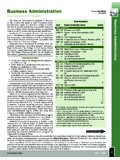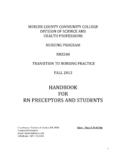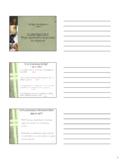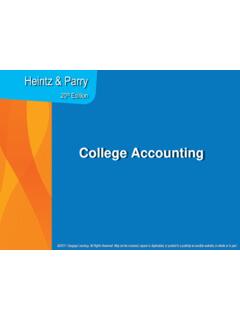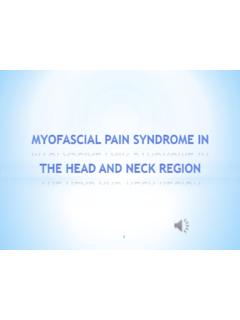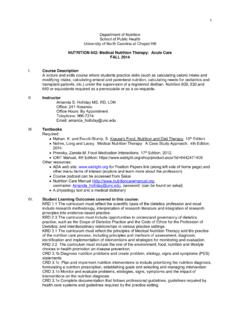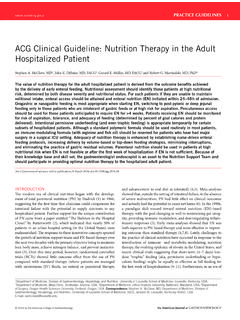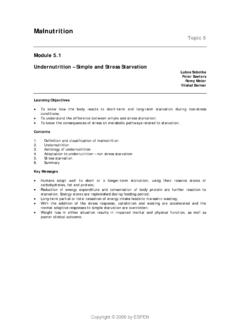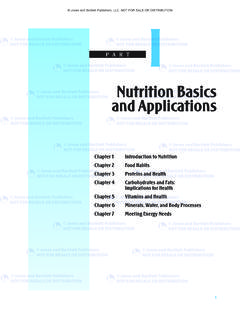Transcription of HPE101 - Basic Concepts of Nutrition
1 COURSE OUTLINE Course Number Course Title Credits HPE 101 Basic Concepts OF Nutrition 3 3 0 0 0 10 or 14 week Class or Laboratory clinical or Practicum, Course Lecture Hours Work Hours Studio Hours Co-op, Internship Length NONE Traditional & Online Performance on an Examination/Demonstration Delivery Methods (Placement Score; minimum CLEP score) (Traditional, Online, Hybrid, Tele-course) COURSE DESCRIPTION This is course emphasizes the fundamental Concepts of Nutrition with a focus on the relationships of nutrients to health, fitness, and athletic performance.
2 Topics include Basic dietary constituents, principles of body function, considerations for disease prevention and management, dietary regulation, dietary myths, food safety and weight management. Prerequisites/Co-requisites MAT 033 and ENG 024 Last Revised: August 2020 Course Coordinator: Mike DeAngelis, MS CSCS, 609-570-3758 Required Text/Other Materials: Nutrition NOW, Judith Brown, 7th Edition INFORMATION RESOURCES: Web Sites: American College of Sports Medicine American Alliance for Health, Physical Education, recreation & Dance US FDA Center for Food Safety and Applied Nutrition Partnership for Food Safety Education International Health, Racquet.
3 And Sports Clubs Association International Society for Aging and Physical Activity Journal of the International Society for Sports Nutrition US Department of Agriculture National Academy for Sports Medicine National Athletic Training Association National Strength and Conditioning Association American Society for Nutrition National Heart Lung and Blood Institute International Society for Sports Nutrition Other Journals (not found on the above web sites): American Journal of Health Behavior clinical Exercise Physiology Other Organizations/Associations: American Association for Active Lifestyles & Fitness American Association for Health Education American Association for Leisure & Recreation National Association for Girls & Women in Sport National Association for Sport & Physical Education National Dance Association Course Goals Upon successful completion of the course, the student will be able 1.
4 Identify and discuss Nutrition problems facing today s society; 2. Identify, distinguish, and discuss the necessities of being an informed consumer of Nutrition products and services; 3. Identify, list, distinguish, and discuss the essential dietary nutrients and their role for good health; 4. Utilize dietary standards and guidelines to determine the nutritional adequacy of an individual s diet for weight management and health; 5. Utilize dietary guidelines for disease prevention and management; 6. Distinguish, identify, and implement/demonstrate optimal Nutrition for fitness and athletic/sport performance; 7.
5 Distinguish, identify, implement/demonstrate safe food handling, preparation, cooking, and serving practices. Course-specific Institutional Learning Goals (ILGs)/General Education Goals: Institutional Learning Goal 1. Written and Oral Communication in English. Students will communicate effectively in both speech and writing. Institutional Learning Goal 2. Mathematics. Students will use appropriate mathematical and statistical Concepts and operations to interpret data and to solve problems. Institutional Learning Goal 3. Science. Students will use the scientific method of inquiry, through the acquisition of scientific knowledge.
6 Institutional Learning Goal 4. Technology. Students will use computer systems or other appropriate forms of technology to achieve educational and personal goals. Institutional Learning Goal 5. Social Science. Students will use social science theories and Concepts to analyze human behavior and social and political institutions and to act as responsible citizens. Institutional Learning Goal 6. Humanities. Students will analyze works in the fields of art, music, or theater; literature; philosophy and/or religious studies; and/or will gain competence in the use of a foreign language.
7 Institutional Learning Goal 7. History. Students will understand historical events and movements in World, Western, non-Western or American societies and assess their subsequent significance. Institutional Learning Goal 8. Diversity and Global Perspective: Students will understand the importance of a global perspective and culturally diverse peoples Institutional Learning Goal 9. Ethical Reasoning and Action. Students will understand ethical frameworks, issues and situations. Institutional Learning Goal 10. Information Literacy: Students will recognize when information is needed and have the knowledge and skills to locate, evaluate, and effectively use information for college level work.
8 Institutional Learning Goal 11. Critical Thinking: Students will use critical thinking skills understand, analyze, or apply information or solve problems. UNITS of STUDY in DETAIL Unit #1 Introduction to Macro- and Micro-nutrients, and Hydration 1. Identify and describe the key Nutrition Concepts and terms; 2. Identify, define, describe, and distinguish what macro-nutrients are, what their purpose is, how they impact our body, and what role they play in our diets; 3. Identify, define, describe, and distinguish what macro-nutrients are, what their purpose is, how they impact our body, and what role they play in our diets; 4.
9 Calculate calories for a given amount of each macro-nutrient; 5. Describe, discuss, and calculate individual metabolic needs based on gender and activity level; 6. Identify and distinguish the different vitamins, their sources, their roles, and possible toxic effects; 7. Identify and distinguish the different minerals, their sources, their roles, and possible toxic effects; 8. Identify and discuss the benefits of proper hydration for non-active as well as active lifestyles. 9. Identify, define, and discuss risks associated with improper of hydration (including but not limited to hyponatremia and heat stroke).
10 10. Identify, describe, and discuss the impact of sugar and artificial sweeteners on health and performance. Course Goals: 1-6; ILG 1,2,3,10, & 11. Unit #2 Principles of Nutrition a Healthy Diet, Metabolism, and Weight Management 1. Identify, analyze, interpret, and discuss Nutrition labeling and how it can be used to maximize dietary decisions for optimal health and performance; 2. Identify, interpret, describe, distinguish, and discuss the information on packaging (including, but not limited to enriched , low fat , organic , etc.); 3. Identify and discuss the growing Nutrition related dangers in society today and they can be addressed; 4.
